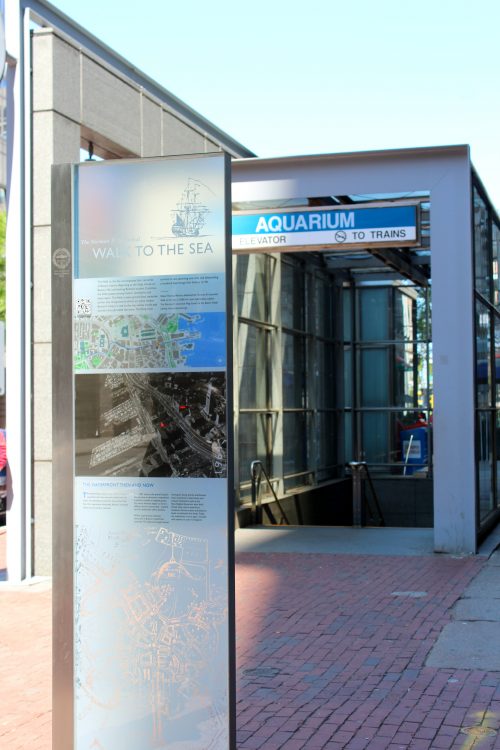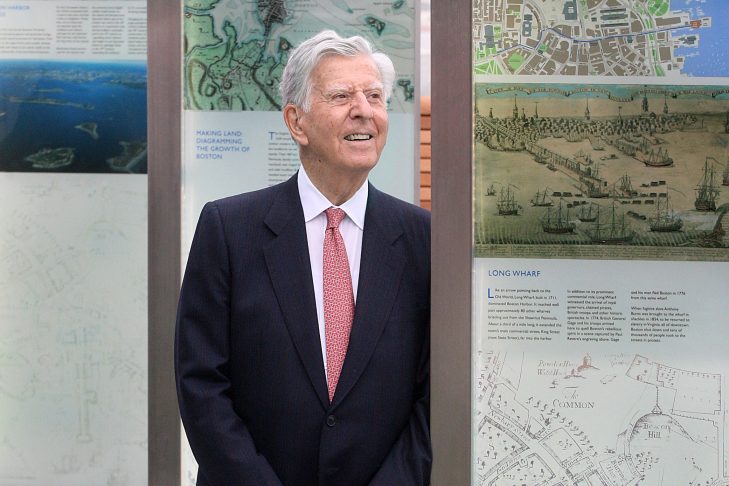In 1939, 22-year-old Norman B. Leventhal’s tax return indicated that his philanthropic life started early. Even in the midst of a depression, Leventhal donated to his alma mater, the Massachusetts Institute of Technology, and Jewish institutions, including Associated Jewish Philanthropies, a precursor to Combined Jewish Philanthropies (CJP). “He was making so little,” Karen Ciampa recently told JewishBoston, “but he found it in himself to give back to the community.” Ciampa was Leventhal’s executive assistant for over a decade, and after his death at 97, three years ago, has stayed on as the director of administration for the family’s philanthropic efforts.
Leventhal would have turned 100 on Aug. 30. Among his many noteworthy accomplishments, and what Ciampa aptly described as “a prominent jewel in Mr. Leventhal’s crown,” is Post Office Square. The park, which opened in 1992, was a decade-long project in which Leventhal eliminated a parking garage—which many considered an eyesore—in the center of Boston’s Financial District and replaced it with seven levels of underground parking. Covering the garage was a 1.7-acre park that was Leventhal’s gift to Boston. In an interview he gave to The Boston Globe in 1997, Leventhal asserted: “We must constantly work to find ways to make the riches of Boston available to all of her citizens, not just the most fortunate among us. That we haven’t succeeded in doing that is no excuse for not continuing our efforts.”
Norman B. Leventhal was born in Boston on Aug. 30, 1917, and grew up in the Dorchester section of the city. He excelled in school and graduated from Boston Latin School at age 15. Although accepted to Harvard, he could not pay the university’s tuition. Instead, he went down the street and matriculated at MIT, from which he graduated in 1938 with a degree in civil engineering. He remained a steadfast supporter of the school for the rest of his life. Among his many generous gifts to the institute were the funds to establish the Muriel and Norman B. Leventhal Center for Jewish Life. Ciampa said Leventhal’s philanthropic goal at MIT was “to enrich students’ lives. His legacy will live on there.”

After MIT, Leventhal and his brother, Robert, worked as navy architects until they founded in 1946 what became The Beacon Companies. Together, the brothers built many of Boston’s well-known landmarks, including Rowes Wharf, the Hotel Meridien, 75 State Street and South Station. One of their first big undertakings was Center Plaza across from Government Center. Ciampa recalled that, “Mr. Leventhal always said the plaza ‘hugged’ Boston.”
Leventhal’s other philanthropic endeavors included Beth Israel Deaconess Medical Center, where he served on the board for many years, and CJP. He was also a founder of Jewish Community Housing for the Elderly, for which he built subsidized housing in Brighton, Brookline and Newton. The Leventhal family also helped to develop the Jewish Community Center in Newton, which bears the family’s name.
Among Leventhal’s favorite philanthropic projects was the Norman B. Leventhal Map Center at the Boston Public Library (BPL). The story and lore behind the founding of the center is that in the 1970s, Leventhal and his wife, Muriel, were shopping in Harrods in London, where he came upon a map of Boston. Immediately intrigued, he bought the map for $50, and when he returned to Boston he began to collect maps of the city. He then expanded his collection to maps from all over the world. Ciampa recalled that initially no one was cataloguing the growing collection, and most of it languished in the BPL’s basement. With an architect friend, Leventhal decided to build a space in the BPL to house his collection, which had grown to 200,000 maps and 5,000 atlases. The goal was to make the collection accessible to scholars and library patrons.

According to the center’s website, there are over 5,500 digitized maps that can be accessed online. For Boston alone, the maps go back to the 1600s, when the Puritans first landed in Massachusetts Bay. There are also maps covering the New England region and the American Revolutionary War, as well maps of urban centers from all over the world.
For Leventhal’s 90th birthday, the late Mayor Thomas Menino honored Leventhal’s unparalleled contributions to the city by establishing the Norman B. Leventhal Walk to the Sea. An enthusiastic walker, Leventhal loved strolling in the city. The walk starts at the State House and ends at Boston Harbor. Along the way eight kiosks guide visitors on the mile-long path. The eight stops are situated in Beacon Hill, King’s Chapel, Government Center, the Old State House, the Financial District, the Custom House, the Rose Kennedy Greenway and Long Wharf. Ciampa fondly described the walk as a “mythical trail. Each kiosk details how that corresponding spot has evolved over 400 years. It’s very popular and educates people about the Boston that Mr. Leventhal loved.”
However, when asked in 2008 what Leventhal thought his greatest accomplishment was, he promptly answered, “Marrying Muriel.” Muriel Leventhal celebrated her 100th birthday last month. Leventhal’s sons, Alan and Mark, residents of Chestnut Hill and Newton, respectively, as well as his daughter, Paula Sidman, of Palm Beach, Fla., carry on their father’s philanthropic legacy.
This post has been contributed by a third party. The opinions, facts and any media content are presented solely by the author, and JewishBoston assumes no responsibility for them. Want to add your voice to the conversation? Publish your own post here. MORE



